Back to > Major Fruits | Minor Fruits | Underutilized Fruits
![]()
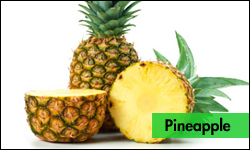 |
||
|
|
Harvesting:
It is difficult to tell when the pineapple is ready to be harvested. A good, ripe fruit has a dull, solid sound. For fresh consumption, fruits are harvested at ‘one- or two-eyes ripe’ meaning that the bottom one or two eyes have turned color. However, the use of this harvest index depends on cultivar as well as the destination of the market. At 127 days after flower induction, the fruits normally reach the stage of 25% shell color i.e. a quarter of the fruit shows an attractive yellow-orange color. Harvesting is usually done between seven and 14 days after the fruit has yellowed. Fruits are normally harvested with a long knife, locally known as ‘parang’ and placed into a basket carried on the back of the harvester. When the peduncle is cut during harvesting, about 3-5 cm of it is left attached to the fruit. It is important to harvest and handle the fruit carefully since any injury can affect the fruit quality and shorten the storage life. Any diseased or abnormal fruits are rejected in the field. Crowns of fruits for local sale are sometimes removed during harvesting and left on top of the plants in the field or are placed in bags to be collected later for planting, but for export markets, they are always retained. From the collection centre, the fruits are manually loaded onto lorries, which transport them to the market place, or to the packinghouse for export. The fruit should be stored at 7.23° C or above, but should be stored for no longer than 4 – 6 weeks.
Pineapple is a non-climacteric fruit which does not improve in quality including sugar accumulation and flavor once they are harvested. Pineapples harvested at more advanced maturity stages (ripened on the plant) have much better flavor and sweetness than the less mature fruit. Immaturity and poor quality are indicated by a hollow thud.
In the worldwide Codex Alimentarius Standard for Pineapple, it is stated that the total soluble solid (TSS) content for harvesting must be higher than 12°Brix. InHawaii, the regulation allows only pineapple with total soluble solids (TSS) of not less than 12°Brix to be harvested and marketed. Minimum TSS content of 12° Brix is also used in Queensland, Australia as a requirement for harvesting.
Sorting and Grading:
Pineapples are selected or sorted manually according to the quality criteria agreed upon by the people involved in the trade. It is a common practice to grade pineapple based on variety, weight, shape, maturity and other factors. Prices are influenced mainly by variety and fruit size. The method is very subjective and can vary according to market or location. It is therefore important to incorporate proper grading and standardization in pineapple handling especially for export. Worldwide Codex Standard for Fresh Pineapple (Codex Stan. 182 – 1993) provides some standard guideline for pineapple.
REVISED CODEX STANDARD FOR PINEAPPLES
CODEX STAN 182-1993 (REV. 1-1999)
1. DEFINITION OF PRODUCE
This standard applies to commercial varieties of pineapples grown from Ananas comosus (L.) Merr. of the Bromeliaceae family, to be supplied fresh to the consumer, after preparation and packaging. Pineapples for industrial processing are excluded.1
2. PROVISIONS CONCERNING QUALITY
2.1 MINIMUM REQUIREMENTS:
In all classes, subject to the special provisions for each class and the tolerances allowed, the pineapples must be:
- whole, with or without the crown;
- fresh in appearance, including the crown, when present, which should be free of dead or dried leaves;
- sound, produce affected by rotting or deterioration such as to make it unfit for consumption is excluded;
- clean, practically free of any visible foreign matter;
- free of internal browning;
- practically free of pests affecting the general appearance of the produce;
- practically free of damage caused by pests;
- free of pronounced blemishes;
- free of damage caused by low and/or high temperature;
- free of abnormal external moisture, excluding condensation following removal from cold storage;
- free of any foreign smell and/or taste.
When a peduncle is present, it shall be no longer than 2.0 cm, and the cut must be transversal, straight and clean. The fruit must be physiologically ripe, i.e., without evidence of
unripeness (opaque, flavourless, exceedingly porous2 flesh) or overripeness (exceedingly translucent or fermented flesh).
_____________________________________________________________________
1. Governments, when indicating the acceptance of the Codex Standard for Pineapples, should notify the Commission which provisions of the Standard would be accepted for application at the point of import, and which provisions would be accepted for application at the point of export.
2. Except in certain varieties such as those of the Queen Group.
2.1.1 The pineapples must have been carefully picked and have reached an appropriate degree of development and ripeness in accordance with criteria proper to the variety and/or commercial type and to the area in which they are grown.
The development and condition of the pineapples must be such as to enable them:
- to withstand transport and handling, and
- to arrive in satisfactory condition at the place of destination.
2.2 MATURITY REQUIREMENTS:
The total soluble solids content in the fruit flesh should be at least 12° Brix (twelve Brix degrees). For the determination of Brix degrees a representative sample of the juice of all the fruit shall be taken.
2.3 CLASSIFICATION:
Pineapples are classified in three classes defined below:
2.3.1 “Extra” Class:
Pineapples in this class must be of superior quality. They must be characteristic of the variety and/or commercial type. They must be free of defects, with the exception of very slight superficial defects, provided these do not affect the general appearance of the produce, the quality, the keeping quality and presentation in the package.
The crown, if present, shall be simple and straight with no sprouts, and shall be between 50 and 150 per cent of the length of the fruit for pineapples with untrimmed3 crowns.
2.3.2 Class I:
Pineapples in this class must be of good quality. They must be characteristic of the variety and/or commercial type. The following slight defects, however, may be allowed, provided these do not affect the general appearance of the produce, the quality, the keeping quality and presentation in the package:
- slight defects in shape;
- slight defects in coloring, including sun spots;
- slight skin defects (i.e., scratches, scars, scrapes and blemishes) not exceeding 4 per cent of the total surface area. The defects must not, in any case, affect the pulp of the fruit. The crown, if present, shall be simple and straight or slightly curved with no sprouts, and shall be between 50 and 150 per cent of the length of the fruit for pineapples with trimmed or untrimmed3 crowns.
______________________________________________________
3 Trimming consist in tearing some leaves off the top of the crown.
2.3.3 Class II:
This class includes pineapples which do not qualify for inclusion in the higher classes, but satisfy the minimum requirements specified in Section 2.1 above. The following defects may be allowed, provided the pineapples retain their essential characteristics as regards the quality, the keeping quality and presentation:
- defects in shape;
- defects in coloring, including sun spots;
- skin defects (i.e., scratches, scars, scrapes, bruises and blemishes), not exceeding 8 per cent of the total surface area.
The defects must not, in any case, affect the pulp of the fruit.
The crown, if present, shall be simple or double and straight or slightly curved, with no sprouts.
3. PROVISIONS CONCERNING SIZING:
Size is determined by the average weight of the fruit with a minimum weight of 700 g, except for small size varieties4, which can have a minimum weight of 250 g, in accordance with the following table:
| Size Code |
Average Weight (+/-12%) (in grams) -with crown- |
Average Weight (+/-12%) (in grams) -without crown- |
| A | 2750 | 2280 |
| B | 2300 | 1910 |
| C | 1900 | 1580 |
| D | 1600 | 1330 |
| E | 1400 | 1160 |
| F | 1200 | 1000 |
| G | 1000 | 830 |
| H | 800 | 660 |
Significant volumes of pineapples in international trade are packaged and sold by count per box.
Boxes are packed to minimum weight expectations e.g. 10 kg, 20 lbs, 40 lbs, appropriate for the various markets. Fruit are segregated for packaging by weights which approximate the above size codes, but may not consistently fall within a single size code, but would retain the uniformity required by the code.
________________________
4 such as Victoria and Queen.
4. PROVISIONS CONCERNING TOLERANCES
Tolerances in respect of quality and size shall be allowed in each inspection lot for produce not satisfying the requirements of the class indicated.
4.1 QUALITY TOLERANCES
4.1.1 “Extra” Class:
Five per cent by number or weight of pineapples not satisfying the requirements of the class, but meeting those of Class I or, exceptionally, coming within the tolerances of that class.
4.1.2 Class I:
Ten per cent by number or weight of pineapples not satisfying the requirements of the class, but meeting those of Class II or, exceptionally, coming within the tolerances of that class.
4.1.3 Class II:
Ten per cent by number or weight of pineapples satisfying neither the requirements of the class nor the minimum requirements, with the exception of produce affected by rotting or any other deterioration rendering it unfit for consumption.
4.2 SIZE TOLERANCES
For all classes, 10 per cent by number or weight of pineapples corresponding to the size immediately above and/or below that indicated on the package.
5. PROVISIONS CONCERNING PRESENTATION
5.1 UNIFORMITY
The contents of each package must be uniform and contain only pineapples of the same origin, variety and/or commercial type, quality and size. For “Extra” Class, colour and ripeness should be uniform. The visible part of the contents of the package must be representative of the entire contents.
5.2 PACKAGING
Pineapples must be packed in such a way as to protect the produce properly. The materials used inside the package must be new,5 clean, and of a quality such as to avoid causing any external or internal damage to the produce. The use of materials, particularly of paper or stamps bearing trade specifications is allowed, provided the printing or labelling has been done with non-toxic ink or glue. Pineapples shall be packed in each container in compliance with the Recommended International Code of Practice for Packaging and Transport of Tropical Fresh Fruit and Vegetables (CAC/RCP 44-1995).
5.2.1 Description of Containers:
The containers shall meet the quality, hygiene, ventilation and resistance characteristics to ensure suitable handling, shipping and preserving of the pineapples. Packages must be free of all foreign matter and smell.
6. MARKING OR LABELLING
6.1 CONSUMER PACKAGES
In addition to the requirements of the Codex General Standard for the Labelling of Pre-packaged Foods (CODEX STAN 1-1985, Rev. 2-1999), the following specific provisions apply:
6.1.1 Nature of Produce:
If the produce is not visible from the outside, each package shall be labelled as to the name of the produce and may be labelled as to the name of the variety and/or commercial type. The absence of the crown should be indicated.
6.2 NON-RETAIL CONTAINERS
Each package must bear the following particulars, in letters grouped on the same side, legibly and indelibly marked, and visible from the outside, or in the documents accompanying the shipment.6 Commission as to which provisions of this Section apply.
_______________________________________________________________________
5 For the purposes of this Standard, this includes recycled material of food-grade quality.
6 Governments, when indicating their acceptance of this Standard, should notify the
6.2.1 Identification:
Name and address of Exporter, Packer and/or Dispatcher. Identification code (optional).7
6.2.2 Nature of Produce:
Name of produce if the contents are not visible from the outside. Name of variety and/or commercial type (optional). The absence of the crown should be indicated.
6.2.3 Origin of Produce:
Country of origin and, optionally, district where grown or national, regional or local place name.
6.2.4 Commercial Identification:
- Class;
- Size (size code or average weight in grams);
- Number of units (optional);
- Net weight (optional).
6.2.5 Official Inspection Mark (optional):
7. CONTAMINANTS
7.1 HEAVY METALS
Pineapples shall comply with those maximum levels for heavy metals established by the Codex Alimentarius Commission for this commodity.
7.2 PESTICIDE RESIDUES
Pineapples shall comply with those maximum residue limits established by the Codex Alimentarius Commission for this commodity.
_______________________________________________________________________
7 The national legislation of a number of countries requires the explicit declaration of the name and address. However, in the case where a code mark is used, the reference “packer and/or dispatcher (or equivalent abbreviations)” has to be indicated in close connection with the code mark.
8. HYGIENE
8.1 It is recommended that the produce covered by the provisions of this Standard be prepared and handled in accordance with the appropriate sections of the Recommended International Code of Practice – General Principles of Food Hygiene (CAC/RCP 1-1969, Rev. 3-1997), and other relevant Codex texts such as Codes of Hygienic Practice and Codes of Practice.
8.2 The produce should comply with any microbiological criteria established in accordance with the Principles for the Establishment and Application of Microbiological Criteria for Foods (CAC/GL 21-1997).
Postharvest Handling and Packaging
Physiological Changes
Endogenous Brown Spot (EBS). EBS is usually associated with exposure of pineapples before or after harvest to chilling temperatures, e.g. below 7°C for one week or longer. Symptoms are water-soaked, brown areas that begin as spots in the core area and enlarge to make the entire center brown in severe cases. The symptoms are not detectable externally unless the fruits are cut and the flesh exposed. The disorder is induced at 5-20 °C, which covers the recommended temperature range for storage of pineapple. A heat treatment at 35°C for one day has been shown to ameliorate EBS symptoms in pineapples transported at 7°C by inhibiting activity of polyphenol oxidase and consequently tissue browning. Waxing is effective in reducing chilling injury symptoms. However, black heart (BH) disorder and post harvest diseases will shorten the storage life of fruits at low temperature. BH, a physiological disorder, is considered the most critical problem in most pineapple producing countries including Australia, Philippines, the United States (Hawaii), Taiwan and Côte d’Ivoire.
Chilling injury. Exposure of pineapples to temperatures below 7°C results in chilling injury. Ripe fruits are less susceptible than unripe or partially-ripe fruits. Symptoms include dull green color when ripened (failure to ripen properly), water- soaked flesh, darkening of the core tissue, increased susceptibility to decay, and wilting and discoloration of crown leaves.
Pathological Disorders
Thielaviopsis rot (black rot, water blister).Caused by Thielaviopsis paradoxa, may start at the stem and advance through most of the flesh with the only external symptom being slight skin darkening due to water-soaking of the skin over rotted portions of the flesh. As the flesh softens, the skin above readily breaks under slight pressure.
Yeast fermentation. Caused by Saccharomyces spp, is usually associated with overripe fruit. The yeast enters the fruit through wounds. Fruit flesh becomes soft and bright yellow and is ruptured by large gas cavities.
Control Strategies:
- Careful handling to minimize mechanical injuries
- Prompt cooling and maintenance of optimum temperature and relative humidity throughout postharvest handling operations.
- Application of fungicides, such as thiabendazole (TBZ).
Postharvest treatment
Types of packaging.
In most countries, pineapple harvested from the field for local and overseas markets are normally heaped onto lorries without using any containers. On arrival in wholesale markets, the fruit are transferred into bamboo or rattan baskets, stackable plastic containers or corrugated fibreboard (CFB) boxes. Despite the packing measures for the pineapple are not standardized, they are guided by the international packing norm for agricultural products according to the size.
In large scale pineapple production, the harvested fruits are deposited in drawers and transported to the packing plant soonest possible. At the packing house, pineapples are first cleaned of dirt, insects and any other foreign matter using blowers or brushes. The slips are removed and the peduncles are cut with a sharp knife to a length not exceeding 2 cm. This is in accordance to the requirement of the Codex Standard. The fruits are cleaned through washing and then submerged in disinfectant in trays as the fruits have to be dried before packing. Another alternative process consists of submerging the fruits completely in similar solution (with Triadimefon), this process is used especially to export to United States and Europe.
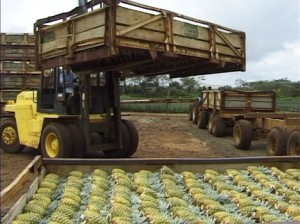 |
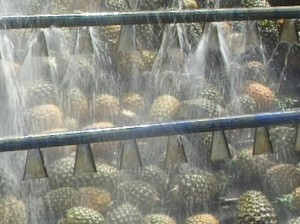 |
The cleaned pineapples should be packed in clean plastic boxes and be stowed. An important characteristic at this stage is that the boxes should have holes with lengthened form in all sides for the ventilation, because it allows a quick exit of the heat of the fruit. The packing also helps to promote the fruit’s sales because of the presentation, as well as the description of content and origin.
The use of appropriate packing for the product fulfills the following functions:
- to avoid the loss of aroma,
- to protect the product against the admission of flavors and disgusting scents,
- to offer a good period of conservation,
- to avoid the accumulation or loss of humidity,
- to protect the product against damages and
- to offer a space to print the necessary information about the product.
The preferred method of packing is to place the fruit vertically on the base of full-telescopic two-piece fiberboard carton with bursting strength 19.96 kg/cm2 and then to place dividers between the fruits to prevent rubbing and movement. Top and bottom ventilation, in addition to side vents are required, particularly where sea-shipments in break bulk are used. Where staples are used in carton construction, care should be taken to ensure complete staples closure to prevent fruit damage. With some cartons, this is not possible and fruit are laid horizontally in alternating directions; where two layers of fruit are packed, a layer of card is required between the layers: 6 counts – 1.75 kg fruit, 12 counts – 1.25 kg fruit, 12 counts – 1.00 kg fruit and 20 counts – 0.75 kg fruit.
Fruits are normally packed to a net weight of 10 to 15 kg depending on the carton and the market. High value small pineapples may be shipped in some instances at 6 kg, whereas the large fruit in some cases may be packed up to 20 kg and finally put in pallets. The boxes used in the packing are carefully checked to detect the presence of insects
In Malaysia, CFB boxes with net weight of 10 kg have been used for export to West Asian countries including Saudi Arabia and United Arab Emirates (UAE). The fruits are arranged in a horizontal position in the box. The crown of each fruit is wrapped with perforated plastic sleeves to control water loss and wilting or yellowing of the crown. Each box contains fruit of uniform size and maturity. The base of the fruit can be lined with sponge to minimize mechanical injury in subsequent handling operations.
Storage and Transportation.
Storage: Pineapples require particular temperature, humidity/moisture and ventilation conditions. Recommended ventilation conditions: air exchange rate 40 – 60 times per hour with constant supply of fresh air, so as constantly to remove the ripening gases arising and to keep the CO2 content of the hold air low. Spoilage may occur as a result both of inadequate ventilation (danger of rotting) and of excessive ventilation (drying-out, weight loss. During storage, the disease can also infect green fruit. Ripe or bruised pineapples are highly susceptible to yeasty rot. Fresh pineapple is also susceptible to fruit rot caused by Ceratocystis paradoxa. The fruit shell becomes water-soaked and disintegrates and the underlying tissue becomes soft, watery and discolored. Both diseases can be managed by careful handling to avoid mechanical damage to the fruit. For control of black rot, dipping the peduncle cut end in 500 ppm benomyl immediately after trimming will provide some control.
Careful crop handling and postharvest contribute to the maintenance of quality of the products. Most pineapple cultivars can normally be stored for 4-5 weeks at 8-10 °C with a relative humidity of 90%. Use of an appropriate packing with a safe and functional protection can keep the quality of the pineapple until arrival to the final market.
For canned pineapple can sizes used are: 608×700 (108 oz), with a net weight of 3030 oz, 6 cans per box and a total weight of 20 kg per box; size 401×411 (30 oz), with a net weight per can of 820 oz, 24 cans per box and a total weight 24 kg per box; size 307×409 (20 oz), with a net weight of 560 oz, 24 cans per box and a total weight of 16 kg per box; size 307×309 (15 oz), with a net weight of 425 oz, 24 cans per box and a total weight of 13 kg per box; and size 307×201 (8 oz), with a net weight of 227 oz, 24 cans per box and a weight of 7 kg per box. The packing is in corrugated cardboard carton to prevent dents during transportation. The packing in tray of 12 cans for retail can size is available with and without shrink wrapping. Products can also be palletized on wooden pallet or slip sheet for the convenience of handling. For industrial use, product of 108 oz. can be palletized without cartons. Pineapple juice is extracted from selected fruits where pulp is controlled to the requirement. NFC (not from concentrate) pineapple juice is single strength at 12 ± 1 °Brix. It is aseptically processed, while some juice will be processed through evaporators to the desired Brix. All juice and concentrate will be stored in cold storage to preserve the quality. Frozen concentrate is stored at the temperature of -20°C. Aseptic product can be stored at the ambient temperature but it is recommended to be stored at 5 °C in order to preserve the quality and to prolong the storage life and packed in steel drum or wooden bin. The canned pineapples are packed in accordance with the US FDA, and are available in different sizes to serve both retail and institutional purposes.
The pallets, properly maintained in refrigeration chambers are loaded in the refrigerated containers. Each container has a capacity of 1500 boxes of 20 kg and/or 3000 approximately boxes of 10 kg. The refrigerated container is maintained at 7.5 – 8° C prior to export. Each container has a thermograph for the control and registration of the temperature while traveling as well as with the respective filters for the control of the ethylene.
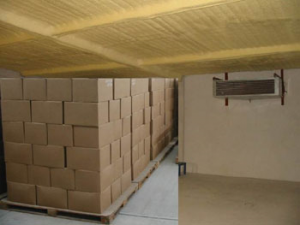 Pineapple refrigeration. |
 Loading of pineapples into container for export market |
Transportation: Marketing and physical distribution of fresh pineapples inherently means moving the produce. The fruits are handled, either manually or mechanically, many times from harvest and through the distribution process before the consumer buys and prepares them to eat.
For domestic transportation the use of road vehicles offers substantial advantages of convenience, availability, flexibility permitting door-to-door delivery, and reasonable cost of transport. The use of road transportation for fresh produce is increasing and likely to increase in countries all over the world. Produce may be transported by pick-up, enclosed truck, open truck or refrigerated vehicle.
In the export market, the Malaysian experience indicates that the fruit can be exported without much problem to Asian markets including Hong Kong, Taiwan, Japan, Korea and West Asia. Pineapple is one of the very few fruits that can be exported to Japan in fresh form without any quarantine restrictions because it is not a host for fruit flies. The fruit can also be exported to Europe provided the total handling time from harvesting till marketing does not exceed 5 weeks. Fresh pineapples have been exported from Malaysia regularly by sea-reefers to West Asia since 1992.
Where sea-shipment is to be used, the fruit should be harvested on the day prior to shipment. Green fruit should be stored at 10ºC, 85 to 95% relative humidity, and under these conditions, should have a storage life of two to three weeks. This will be dependent on the sugar content and the agronomic conditions during production, in addition to the handling and storage procedures. Where exports are made by air with fruit harvested at more advanced stages of maturity, pre-export storage can be used and the suitable storage temperature decreases to 7.5ºC, 85 to 95% relative humidity.
Potential Post-harvest Losses: Losses in pineapples during air-transport are minimal if careful handling is employed. On sea-shipments and long term storage however, the fruit are more susceptible to post-harvest losses as a result of increased handling, control of temperature and disease incidence.
Mechanical damage: Bruising or puncturing caused by poor handling, dropping or abrasion, will result in localized areas of softening and development of secondary microbial infection.
Processed Products:
Types of products:
Traditionally pineapple is consumed fresh or canned. Diversification of pineapple products is a good strategy to increase consumption in the main markets of the world. Thus, pineapple is consumed in the form of single strength or concentrated juice, dehydrated and/or sugared, canned in slices or bits. Among the newer developments are dried chips, cocktail-type drinks, dried powdered, isotonic mixtures and wine; there are also new canned forms as whole fruit, bars, flakes and cubes. For fresh consumption, new varieties have been introduced: MD2, Josapine, LR41 and Gandul.
Essentially a prime table fruit, pineapple pulp is perfectly suited for conversion to frozen juices, nectars, drinks, jams, fruit cheese, concentrates or to be had by itself or with cream as a superb dessert. It can also be used in puddings, bakery fillings, and fruit meals for children, flavors for food industry, and also to make the most delicious ice cream and yoghurt. While the raw fruits are utilized for products like chutney, pickle, sauce. pineapple beverage, etc. ripe ones are used in making pulp, juice, nectar, squash, leather, slices, etc. Ripe pineapple may be frozen whole or peeled, sliced and packed in sugar (1 part sugar to 10 parts pineapple by weight) and quick-frozen in moisture-proof containers. The diced flesh of ripe pineapple, bathed in sweetened or unsweetened lime juice, to prevent discoloration, can be quick-frozen. Half-ripe or green pineapples are peeled and sliced as filling for pie, used for jelly, or made into sauce. They are also eaten raw, dried, in confectionaries and a juice is extracted. Cores have been made into candles. Pineapple juice concentrate, either in frozen or aseptic packaging, is also growing in popularity.
The juice is the source of denatured alcohol and an alcoholic beverage, ‘Vin d’ Ananas’. Pressed peels and cores are used as food for livestock.
Pineapple waste is made into vinegar and soap. Leaves are a source of a hard fiber called ‘Pina Fibre’. The fruit which must be ripened on the plant contains about 15 percent sugar plus fruit acids, vitamins and minerals. There are many different varieties cultivated. In many countries, pineapple is also made into jam and used in the making of pineapple tarts, which is very popular especially during festive seasons.
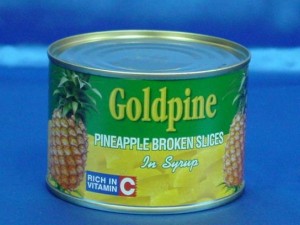 |
 |
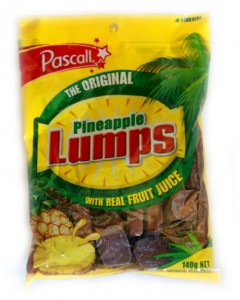 |
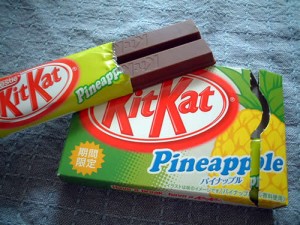 |
Industrial processing possibilities of pineapple:
| pinapple pulp | Glazings |
| Fruit cocktails | Dried pineapple slices |
| Juice | Pineapple wine |
| Nectar | Flavored yoghurt |
| Fruit sauces | Ice cream |
Processing techniques:
At the cannery, fruit are unloaded from trailer trucks to conveyor bands where crowns are taken off and fruit are placed in a washing vat, then through an elevator the pineapples go to a roller sorter, and then separated in two different sizes and two slides take the fruit to different packing lines. Then they are peeled and cored by a machine called a Ginaca, named after its Hawaiian inventor, Henry Ginaca. The coreless cylinder is then moved to the dicer and the product is then ready to be packed in buckets holding 10 to 15 kg. The product is frozen in a chamber set at -20°C, for further transfer to distribution points or processing. Pineapple cylinders are sliced and canned with syrup, then passed through an exhauster with steam at 3 bar and 120 °C to eliminate air and create vacuum. Cans are sealed and sent to the autoclave. After the thermal treatment the cans are placed in a cooling vat for 10 minutes; this produces a thermal shock that inactivates bacteria. Finally, cans are labeled and boxed and ready for distribution.
The highest grade canned product is the skinned, cored fruit sliced cross-wise and packed in syrup. Pineapple may also be canned in chunks, wedges, tidbits or as crushed pineapple canned in its own juice.
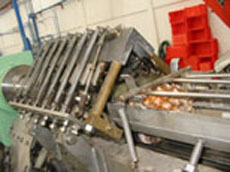 Ginaca peeler. |
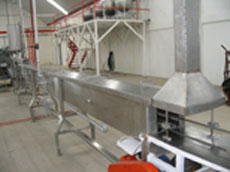 Exhauster |
Other different products of pineapple processing are:
Dried pineapple: In this product, most of the free water of the fruit is eliminated. Usually, chunks or slices are prepared for better presentation and make handling easier. Final moisture is near 5%, and this allows the dried fruit to have a long shelf life as long as proper packing is provided and storage is done in a fresh place.
Juice: Pineapple juice is obtained from crushing fruit pieces and proper physical separation of the solids. Juice must be pasteurized and packed to extend its shelf life and a preservative or refrigerated storage may be used as additional barriers to microbial spoilage. No juice should reach the market if it becomes fermented or mixed with water. Packing may be plastic bottles or bags, coated cans, multi-laminate (plastic, paper, metal foil) or any newer materials. The pH values of the product must be controlled so it remains agreeable for human consumption. It is a common practice to blend batches of juices to attain proper acidity and sensory qualities. Juices from other fruits can be blended with pineapple’s and interesting mixtures make novel products.
Nectar: It is the product of blending juice with a certain amount of solids from the p ulp containing the same amount of °Brix as the original fruit. Normally, nectars are prepared by diluting fruit pulp to 30 °Brix. Methods of preservation and packing are similar to those described for juice.
Pulp: It is the product of the basic processing of peeled pineapple pulp by crushing. Pulp may be preserved by thermal treatment, by preservatives addition and proper handling in either small packages, or in bulk packages for further industrial processing and formulations as ice cream mixes, jellies, jams, sodas, etc.
Concentrated frozen pulp: It is the product from thermal treatment of the pulp to remove at least 50% of the initial water content. Concentration and freezing are applied to preserve the pulp for extended periods of time. The concentrated pulp is stable without the addition of chemicals as long as it is kept frozen. Upon reconstitution (by replenishing the previously eliminated water) the pulp should have the same qualities as the original pulp.
Aseptic pulp: It is the pulp that was heat-sterilized and packed aseptically; no chemicals are added and has a long shelf life. There is very specific equipment to perform this process and it is considered to be at the cutting edge of technology.
Concentrated Frozen Juice: This product is prepared by direct application of heat to pineapple juice to reduce its water content. Preservation methods are similar as described for concentrated pulp in which no chemical additives are used.
Jelly: Jellies fall in the group of fruit preserves, which are defined as semisolid products prepared by mixing 45 parts of fruit and 55 parts of sugar. This mixture is cooked until the final solids contents reach 65 to 68%. It is hot-filled for better stability. Usually, jellies are prepared from fruit juice and a gel-type product is obtained; it may or may not contain fruit pieces. Final textural firmness is dependent of the type of gel-forming agent as pectin which is added under controlled acidity and solids content to assure the proper texture of the product. To assure proper shelf life at ambient temperature, preservatives may be added. These chemicals are mainly used to control mold growth; but once the jar is open, it shall be stored under refrigeration.
Marmalades: This is also considered as a fruit preserve using the same proportions of fruit and sugar, and cooked until the same solids content as jellies. Consistency is semi-fluid and not a gel as jellies. Preservation criteria and shelf life considerations are similar as for jellies
Fillings: Pineapple pieces mixed with bakery cream may be used as cake fillings for institutional service and large-scale production of bakery goods. Stability of the product depends on the cleanliness and hygiene of the manufacturing process. Product may be packed in plastic bags, plastic containers or metal bins. If no additives are used, the fillings must be kept refrigerated. Due to its elevated nutrient and water content, shelf life is not very long.
Vinegar: Vinegar is prepared by an acetic fermentation of alcohol solutions derived from sugar or starchy materials (fermentable sugar content of 8-20%). This is done by strains isolated from the raw materials. Peel and other pineapple by-products from processing can be used as raw materials to prepare natural vinegar and thus make a proper use of residuals. Vinegar must be pasteurized once it is prepared and bottled. It is stable at ambient temperature.
Sauce: Concentrate 1 kg strained pulp containing 20 g sugar to 1/3 of its original volume in the presence of suspended spice bag containing 50 g chopped onion, 5 g garlic and 50 g ginger, 10 g powdered spices and 5 g red chillies. Press out spice bag occasionally and squeeze it out finally to obtain maximum spice extract. Add 15 g salt and remaining 40 g sugar and cook to thick consistency. Add 450 ml vinegar and cook again to end point. Add and mix preservative after dissolving in minimum quantity of water. Heat to boiling and hot pack.
Jam: Boil 1 kg pulp of ripe firm peeled fruit with 100 ml water 3 g citric acid and 10 g of pectin. Add 750 g sugar and cook to thick consistency. End point is confirmed by sheet test. Boiling mass is allowed to fall after cooking from a laddle which will flow in the form of a sheet. Pack hot in clean dry glass jars.
Jelly: Mix 1 kg grated pulp of fully mature peeled but somewhat raw fruits with ripe pineapple pulp (1 kg), 2.5 litre water 10 g citric acid and 2 g of pectin. Boil for 30 min, cool and allowed to settle for 2 hours. Separate the supernatant (upper layer) and filter. Test for pectin quality. Formation of single clot with small quantity of ethyl alcohol added to test samples indicates high pectin content. Concentrate further if necessary to obtain single clot. Cook gently the extract with equal quantity of sugar to obtain the end point indicated by the formation of sheet. Pack hot. Cover with a layer of melted wax and close the lid.
Preserve and candy: Cut rectangular slices (4×1 cm) or suitable sized cubes from the fully mature ripe washed peeled fruits after removing seeds. Keep in 1.5 % lime water for 3-4 hours. Drain and wash 3-4 times in plain water. Dissolve 400 g sugar in 600 ml hot water and filter. Boil pieces in sugar syrup and keep overnight. Next day drain the syrup, raise its Brix to 50. Add slices, boil and keep again. Repeat this process every day, until Brix reaches 70-75°. Keep for a week. Drain the syrup, fill the pieces in dry jars and cover slices with freshly prepared sugar syrup of 70°Bx.
For the preparation of candy, raise the Brix of syrup to 75°, and keep it for a week. Drain and dry the pieces under shade. Dip pieces in boiling water to remove adhering sugars. Drain, dry and pack
Toffee: Concentrate 1 kg sieved pulp to 1/3 volume and cook with added sugar (600 g), glucose (100 g) and hydrogenated fat (100 g) till a speck of the product put into water forms compact solid mass. Make thick paste of 100 g skim milk powder in minimum quantity of water and mix with the boiling mass. Spread 1-2 cm thick layer of the cooked mass over /SS trays smeared with fat. Add flavoring material at this stage, if necessary. Allow to cool. Cut and wrap in butter paper.
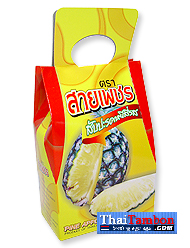 Candy |
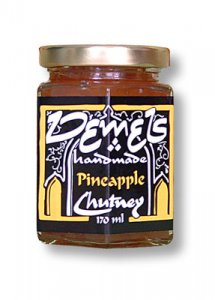 Pineapple Chutney |
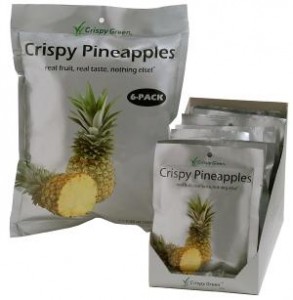 Dried pineapple |
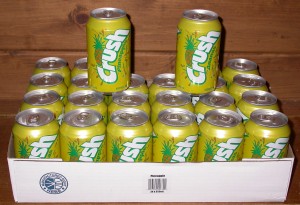 Carbonated Drink |
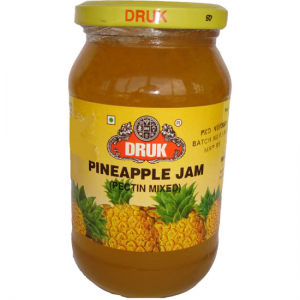 Pineapple Jam |
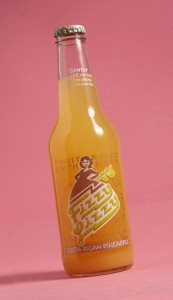 Juice |
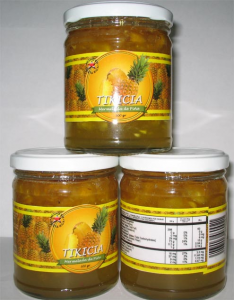 Pineapple Marmalade |
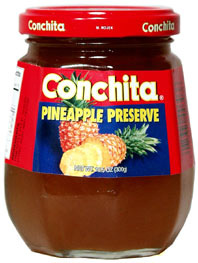 Preserve |
 Pineapple Sauce |
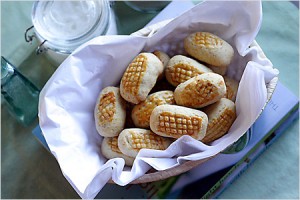 Pineapple Tarts |
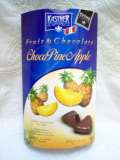 Pineapple Toffee |
 Vinegar |
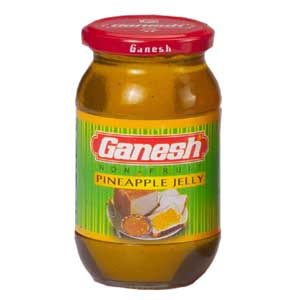 Pineapple Jelly |
Packaging of products
Nutritional and medicinal values
Pineapple contains a proteolytic enzyme bromelain, which digests food by breaking down protein. Bromelain is very effective in treating bruises, sprains and strains by reducing swelling, tenderness and pain. This powerful anti-inflammatory effect can also help relieve rheumatoid arthritis symptoms and reduce post-operative swelling. In addition, bromelain relieves indigestion, as the enzyme helps break down the amino acid bonds in proteins, which promotes good digestion. Unfortunately, most of the bromelain in canned pineapples is destroyed due to the heat used in the canning process. Pineapples also provide an ample supply of Vitamin C, an anti-oxidant that protects the body from free radical damage and boosts the immune system. Vitamin C helps build and repair bodily tissue and promotes wound healing. The body uses Vitamin C to metabolize fats and cholesterol, absorb iron, and synthesize amino acids and collagen. Vitamin C also decreases the severity of colds and infections. Other advantages are that the fruit is fat-free, has very low sodium and is also cholesterol-free. Meanwhile, pineapple juice can be used as a marinade and tenderizer for meat. The enzymes in pineapples can interfere with the preparation of some foods, such as jelly or other gelatin-based desserts. These enzymes can be hazardous to someone suffering from certain protein deficiencies or disorders, such as Ehlers-Danlos syndrome. Pineapples should also not be consumed by those with Hemophilia or by those with kidney or liver disease, as it may reduce the time taken to coagulate a consumer’s blood.
There is significant evidence pointing to the anti-inflammatory benefits of bromelain. Because of this naturally occurring enzyme, the natural juice of a pineapple can, in substantial quantities, eat away at simple flesh structures like finger prints or ulcers.
Consumers of pineapple have claimed that pineapple has benefits for some intestinal disorders; others claim that it helps to induce childbirth when a baby is overdue.

